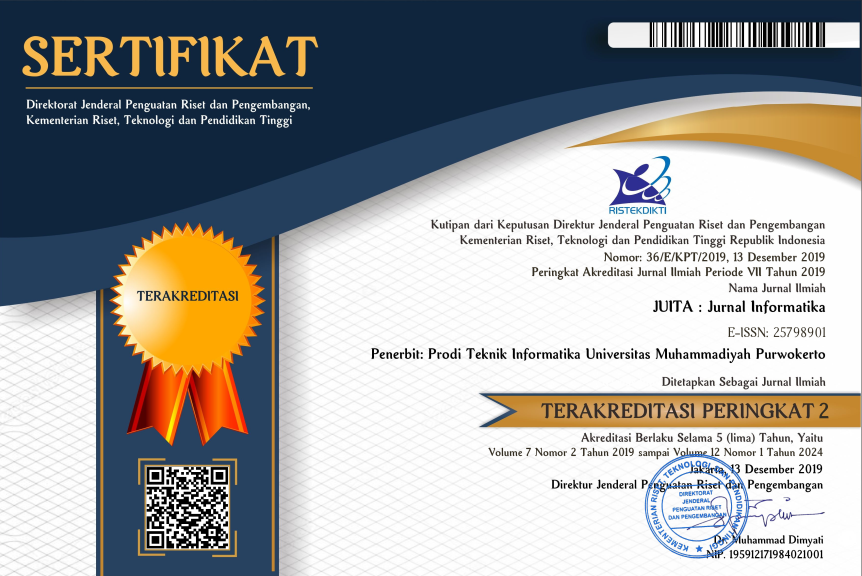Selection of TikTok Content Based on User Engagement Criteria Using the Analytic Hierarchy Process
DOI:
https://doi.org/10.30595/juita.v11i1.16314Keywords:
tik tok, engagement, AHP, COBRA ConceptAbstract
Indonesia has 106.9 million active TikTok users aged 18 and above. TikTok is designed for engagement in many ways, as it actively encourages two-way communication and eye-catching content. Uploaded content must have its uniqueness variable. In increasing the engagement of a TikTok account, criteria are chosen based on the COBRA concept (consuming, contributing, and creating) and alternatives based on social media content trends in Indonesia (tutorial, educational, a day in my life, behind the scene dan tips and trick). This research was conducted by implementing the Analytic Hierarchy Process (AHP) method to select the content that must be prioritized to get engagement from the wider community. From the data processing results obtained, tutorial content is the best content in increasing engagement results, especially TikTok. Content that has the lowest engagement is behind the scene content. Further research can be carried out through a group decision support system with various related experts. It can also be combined with the BORDA, TOPSIS, and Profile Matching methods to optimize ranking results.References
[1] A. M. Kaplan and M. Haenlein, “Users of the world, unite! The challenges and opportunities of Social Media,” Bus Horiz, vol. 53, no. 1, pp. 59–68, Jan. 2010, doi: 10.1016/j.bushor.2009.09.003.
[2] C. K. Prahalad and V. Ramaswamy, The future of competition: Co-creating unique value with customers. Boston, Mass. : Harvard Business School Press, 2004.
[3] P. M. di Gangi and M. Wasko, “Social media engagement theory: Exploring the infuence of user engagement on social media usage,” Journal of Organizational and End User Computing, vol. 28, no. 2, pp. 53–73, Apr. 2016, doi: 10.4018/JOEUC.2016040104.
[4] We are social, “ANOTHER YEAR OF BUMPER GROWTH,” 2022.
[5] TikTok, “Essential TikTok statistics and trends for 2022,” 2022. https://datareportal.com/essential-tiktok-stats (accessed Jan. 09, 2023).
[6] TikTok, “TikTok data report of 2019,” 2020. Accessed: Jan. 09, 2023. [Online]. Available: http://www.360doc.com/content/20/0107/07/10240337_884633580.shtml.
[7] K. Wiley, K. Schwoerer, M. Richardson, and M. B. Espinosa, “Engaging stakeholders on TikTok: A multi-level social media analysis of nonprofit Microvlogging,” Public Adm, 2022, doi: 10.1111/padm.12851.
[8] K. S. Meng and L. Leung, “Factors influencing TikTok engagement behaviors in China: An examination of gratifications sought, narcissism, and the Big Five personality traits,” Telecomm Policy, vol. 45, no. 7, Aug. 2021, doi: 10.1016/j.telpol.2021.102172.
[9] D. Nazarov, A. Nazarov, and A. Nazarova, “Model of Fuzzy Assessment of the Account’s Content in the TikTok Social Network,” in 15th IEEE International Conference on Application of Information and Communication Technologies, AICT 2021, 2021. doi: 10.1109/AICT52784.2021.9620309.
[10] N. Hoang Khoa, P. The Duy, H. do Hoang, D. Thi Thu Hien, and V.-H. Pham, “Forensic analysis of TikTok application to seek digital artifacts on Android smartphone,” in 2020 RIVF International Conference on Computing and Communication Technologies (RIVF), Oct. 2020, pp. 1–5. doi: 10.1109/RIVF48685.2020.9140739.
[11] D. B. V. Kaye, X. Chen, and J. Zeng, “The co-evolution of two Chinese mobile short video apps: Parallel platformization of Douyin and TikTok,” Mob Media Commun, vol. 9, no. 2, pp. 229–253, May 2021, doi: 10.1177/2050157920952120.
[12] D. G. Muntinga, M. Moorman, and E. G. Smit, “Introducing COBRAs,” Int J Advert, vol. 30, no. 1, pp. 13–46, Jan. 2011, doi: 10.2501/ija-30-1-013-046.
[13] D. Cao, M. Meadows, D. Wong, and S. Xia, “Understanding consumers’ social media engagement behaviour: An examination of the moderation effect of social media context,” J Bus Res, vol. 122, pp. 835–846, Jan. 2021, doi: 10.1016/j.jbusres.2020.06.025.
[14] L. Dessart, “Social media engagement: a model of antecedents and relational outcomes,” Journal of Marketing Management, pp. 1–25, Mar. 2017, doi: 10.1080/0267257X.2017.1302975.
[15] B. Schivinski, G. Christodoulides, and D. Dabrowski, “Measuring consumers’ engagement with brand-related social-media content: Development and validation of a scale that identifies levels of social-media engagement with brands,” J Advert Res, vol. 56, no. 1, pp. 64–80, Mar. 2016, doi: 10.2501/JAR-2016-004.
[16] S. N. Tisha, M. T. Abed, and M. G. R. Alam, “Decision Theory-based Content Selection and Ranking for Social Media Newsfeed using Fuzzy Analytic Hierarchy Process,” in TENSYMP 2021 - 2021 IEEE Region 10 Symposium, Aug. 2021. doi: 10.1109/TENSYMP52854.2021.9550917.
[17] A. D. S. Sirait, W. R. Fitriani, A. N. Hidayanto, B. Purwandari, and M. Kosandi, “Evaluation of social media preference as e-participation channel for students using fuzzy AHP and TOPSIS,” in Proceedings - 2018 4th International Conference on Computing, Engineering, and Design, ICCED 2018, Apr. 2019, pp. 158–163. doi: 10.1109/ICCED.2018.00039.
[18] A. Perdana, “15 Jenis Konten TikTok untuk Brand yang Meraih Banyak Views,” 2023. https://glints.com/id/lowongan/jenis-konten-tiktok-untuk-brand/#.Y-W5MXZBy5d (accessed Feb. 10, 2023).
[19] I. Hilal Ramadhan, R. Priatama, A. Akalili, and F. Kulau, “Analisis Teknik Digital Marketing pada Aplikasi Tiktok (Studi Kasus Akun TikTok @jogjafoodhunterofficial),” online) Socia: Jurnal Ilmu-ilmu Sosial, vol. 18, no. 1, pp. 49–60, 2021.
Downloads
Published
How to Cite
Issue
Section
License

JUITA: Jurnal Informatika is licensed under a Creative Commons Attribution 4.0 International License.
















